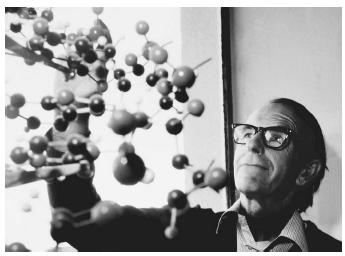Frederick Sanger
BRITISH CHEMIST
1918–
Frederick Sanger is surely one of the most outstanding biochemists of modern times. His methods for determining the exact sequence of amino acids in proteins and of nucleotides in deoxyribonucleic acid ( DNA ) have won him numerous awards, including two Nobel Prizes in chemistry.
Sanger was born on August 13, 1918, in the village of Rendcombe in Gloucestershire, England. He attended St. John's College, Cambridge University,

from which he received a B.A. in biochemistry in 1939. He remained at Cambridge as a conscientious objector during World War II and earned his Ph.D. in biochemistry for work on amino acid metabolism and the nitrogen of potatoes with Albert Neuberger in 1943. Later that year he joined Antony C. Chibnall's group at Cambridge and began research on proteins and, in particular, insulin.
The basic principles of protein chemistry were firmly established when Sanger started his work on insulin. It was known that proteins were composed of amino acids linked through amide bonds to form long polypeptide chains. Although the relative number of each of the twenty amino acids could be obtained for a given protein, the particular order, or sequence, of those amino acids in the protein had never been determined. Sanger saw sequence as the key to understanding living matter and set out to determine the exact sequence of amino acids in insulin.
Sanger first needed to characterize the free amino groups in insulin. For this he developed a reagent , dinitrofluorobenzene (FDNB), that reacted with amino groups present in proteins to form an acid-stable dinitrophrenyl (DNP) derivative. The DNP protein was treated with acid to break the polypeptide backbone, and the free DNP amino acid derivatives were isolated and compared to standards prepared from known amino acids. In this way, Sanger determined that insulin was made up of two peptide chains: one (chain A) with an amino-terminal glycine residue and another (chain B) with an amino-terminal phenylalanine. Subsequent work revealed that chain A was composed of twenty amino acids and chain B thirty-one.
The individual chains were then broken down into smaller components: Acid was used to cleave the polypeptide backbone, performic acid was used to break the cysteine disulfide bonds , and proteolytic enzymes were used to hydrolyze the polypeptide at specific sites on the chain. The reaction products were separated from each other and their sequence determined.
Sanger was able to deduce the complete sequence of insulin after twelve years of painstaking research and molecular puzzle solving. The Nobel committee was quick to recognize Sanger's accomplishment and awarded him the 1958 Nobel Prize in chemistry for "his work on the structure of proteins, especially that of insulin."
In 1962 Sanger moved to the Medical Research Council Laboratory of Molecular Biology in Cambridge, where he became interested in nucleic acid sequencing. He and his colleagues developed a cleave-and-sequence method for small ribonucleic acid (RNA) molecules, but they soon realized that a different method was needed to sequence the much larger DNA molecules. For DNA sequencing, he chose to investigate copying procedures.
Sanger eventually settled on a procedure that uses DNA polymerase to copy short fragments (200 nucleotides) of single-stranded DNA obtained from enzyme-catalyzed cleavage of the parent DNA. In addition to the usual radiolabeled deoxyribonucleotide triphosphates, the DNA synthesis cocktail contains a 2′, 3′-dideoxy analog that is incorporated into the growing DNA strand and blocks further DNA synthesis. After repeating the reaction using each of the remaining dideoxy nucleotides, the various chain-terminated fragments are separated by gel electrophoresis and the DNA sequence read directly from the gel. Sanger used this method to sequence a DNA containing more than 5,000 nucleotides and shared the 1980 Nobel Prize in chemistry for "contributions concerning the determination of base sequences in nucleic acids."
Sanger retired in 1983 after forty years of service at the Medical Research Council and after helping to usher in a new era in biology and medicine.
SEE ALSO DNA Replication ; Insulin ; Proteins .
Thomas M. Zydowsky
Bibliography
James, Laylin K., ed. (1993). Nobel Laureates in Chemistry 1901–1992. Washington, DC: American Chemical Society; Chemical Heritage Foundation.
Internet Resources
Sanger, Frederick (1958). "The Chemistry of Insulin." Nobel e-Museum. Available from http://www.nobel.se/chemistry/laureates .
Sanger, Frederick (1980). "Determination of Nucleotide Sequences in DNA." Nobel e-Museum. Available from http://www.nobel.se/chemistry/laureates .